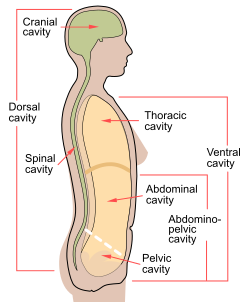| Body cavity | |
|---|---|
 Cross-section showing cavities in the human body, the dorsal and ventral body cavities labelled. | |
 Cross-section of an oligochaete worm. The worm's body cavity surrounds the central typhlosole. | |
| Identifiers | |
| FMA | 85006 |
| Anatomical terminology | |
A body cavity is any space or compartment, or potential space, in an animal body. Cavities accommodate organs and other structures; cavities as potential spaces contain fluid.
The two largest human body cavities are the ventral body cavity, and the dorsal body cavity. In the dorsal body cavity the brain and spinal cord are located.
The membranes that surround the central nervous system organs (the brain and the spinal cord, in the cranial and spinal cavities) are the three meninges. The differently lined spaces contain different types of fluid. In the meninges for example the fluid is cerebrospinal fluid; in the abdominal cavity the fluid contained in the peritoneum is a serous fluid.
In amniotes and some invertebrates the peritoneum lines their largest body cavity called the coelom.